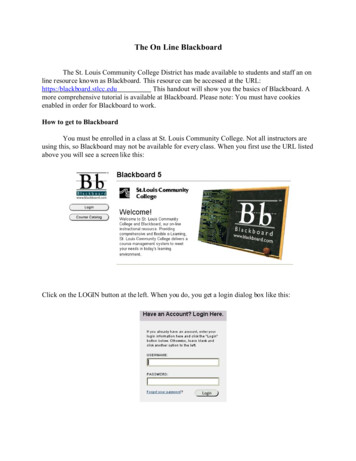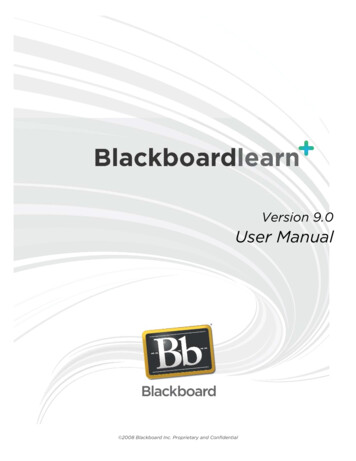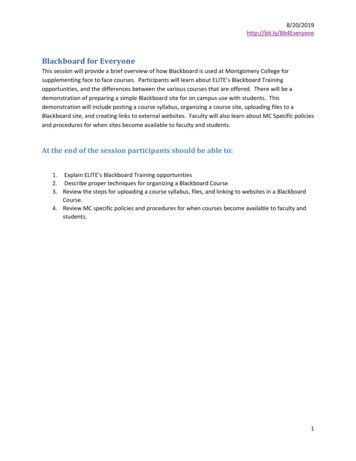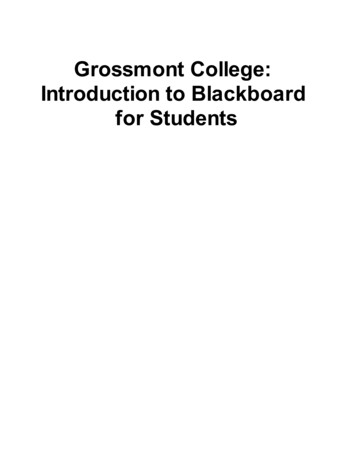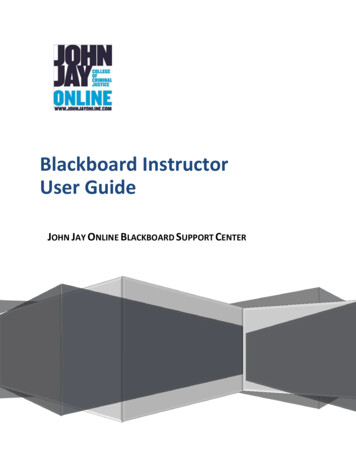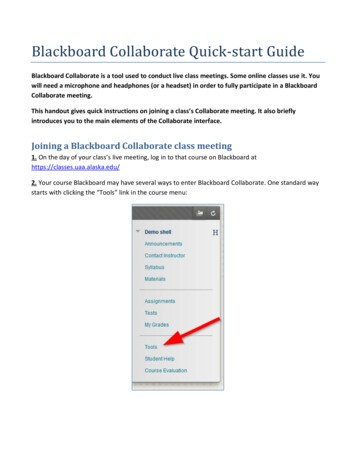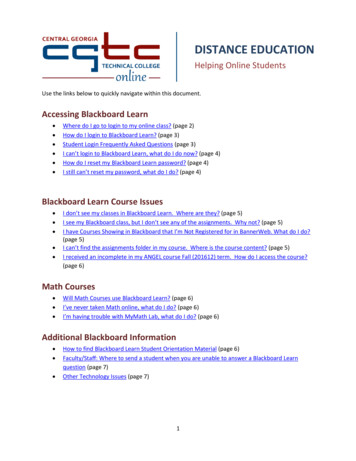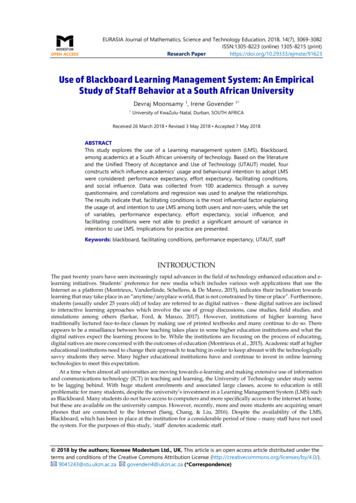
Transcription
OPEN ACCESSEURASIA Journal of Mathematics, Science and Technology Education, 2018, 14(7), 3069-3082ISSN:1305-8223 (online) 1305-8215 (print)Research Paperhttps://doi.org/10.29333/ejmste/91623Use of Blackboard Learning Management System: An EmpiricalStudy of Staff Behavior at a South African UniversityDevraj Moonsamy 1, Irene Govender11*University of KwaZulu-Natal, Durban, SOUTH AFRICAReceived 26 March 2018 Revised 3 May 2018 Accepted 7 May 2018ABSTRACTThis study explores the use of a Learning management system (LMS), Blackboard,among academics at a South African university of technology. Based on the literatureand the Unified Theory of Acceptance and Use of Technology (UTAUT) model, fourconstructs which influence academics’ usage and behavioural intention to adopt LMSwere considered: performance expectancy, effort expectancy, facilitating conditions,and social influence. Data was collected from 100 academics through a surveyquestionnaire, and correlations and regression was used to analyse the relationships.The results indicate that, facilitating conditions is the most influential factor explainingthe usage of, and intention to use LMS among both users and non-users, while the setof variables, performance expectancy, effort expectancy, social influence, andfacilitating conditions were not able to predict a significant amount of variance inintention to use LMS. Implications for practice are presented.Keywords: blackboard, facilitating conditions, performance expectancy, UTAUT, staffINTRODUCTIONThe past twenty years have seen increasingly rapid advances in the field of technology enhanced education and elearning initiatives. Students’ preference for new media which includes various web applications that use theInternet as a platform (Montrieux, Vanderlinde, Schellens, & De Marez, 2015), indicates their inclination towardslearning that may take place in an “anytime/anyplace world, that is not constrained by time or place”. Furthermore,students (usually under 25 years old) of today are referred to as digital natives – these digital natives are inclinedto interactive learning approaches which involve the use of group discussions, case studies, field studies, andsimulations among others (Sarkar, Ford, & Manzo, 2017). However, institutions of higher learning havetraditionally lectured face-to-face classes by making use of printed textbooks and many continue to do so. Thereappears to be a misalliance between how teaching takes place in some higher education institutions and what thedigital natives expect the learning process to be. While the institutions are focusing on the process of educating,digital natives are more concerned with the outcomes of education (Montrieux et al., 2015). Academic staff at highereducational institutions need to change their approach to teaching in order to keep abreast with the technologicallysavvy students they serve. Many higher educational institutions have and continue to invest in online learningtechnologies to meet this expectation.At a time when almost all universities are moving towards e-learning and making extensive use of informationand communications technology (ICT) in teaching and learning, the University of Technology under study seemsto be lagging behind. With huge student enrolments and associated large classes, access to education is stillproblematic for many students, despite the university’s investment in a Learning Management System (LMS) suchas Blackboard. Many students do not have access to computers and more specifically access to the internet at home,but these are available on the university campus. However, recently, more and more students are acquiring smartphones that are connected to the Internet (Sang, Chang, & Liu, 2016). Despite the availability of the LMS,Blackboard, which has been in place at the institution for a considerable period of time – many staff have not usedthe system. For the purposes of this study, ‘staff’ denotes academic staff. 2018 by the authors; licensee Modestum Ltd., UK. This article is an open access article distributed under theterms and conditions of the Creative Commons Attribution License 243@stu.ukzn.ac.zagovenderi4@ukzn.ac.za (*Correspondence)
Moonsamy & Govender / Use of Blackboard Learning Management SystemContribution of this paper to the literature The results of this study point to the need for strong support systems for academic staff at HEIs to adoptLMS for effective teaching and learning.This study provides strong empirical confirmation that performance expectancy has a direct impact onbehavioural intention to use a LMS.Allocating more time for technology enhanced teaching in the teaching workload of staff is just as importantas having the infrastructure in place to influence behavioural intention and usage of the system. With such a huge investment in time and money on acquiring and installing the LMS, Blackboard, it has becomenecessary to understand how and to what extent these technologies are being used, and to determine theperceptions of staff on the use of Blackboard. To this end, the study aims to investigate the perceptions of stafftowards the use of Blackboard in teaching and learning and subsequently to understand the reasons for the slowadoption of Blackboard by staff. In order to determine the perceptions of staff, the research was guided by thefollowing research questions:1. What are the perceptions of staff on the use of Blackboard?2. To what extent does performance expectancy, effort expectancy, social influence and facilitating conditionsinfluence academics to use Blackboard?In the next section an overview of the literature related to LMS and staff perceptions are explained, followed bya description of the methodology used. Thereafter the analysis is presented followed by a discussion andimplications for practice.LITERATURE REVIEWOnline LearningIn the last decade, the trend in education has been a move towards online instruction and “blended” instructionwhich replaces components of face-to-face instruction. Poon (2013) considers blended learning to be thecombination of online and face-to-face learning. Blended instruction is often designed with the use of a learningmanagement system to facilitate teaching and learning (Govender & Mkhize, 2015).In the late 1990s, a significant transition in e-learning emerged as a result of the introduction of LearningManagement Systems (LMSs). Among the popular examples of learning management systems are Blackboard,Moodle, and WebCT which are designed to facilitate web based learning (Kulshrestha & Kant, 2013). A learningmanagement system (LMS) is a web enabled software platform designed to ensure efficient management anddelivery of learning materials to students (Govender & Govender, 2012). Communication tools that a LMS providesenable easy interactions between lecturer and student and among students. LMSs enable various assessments suchas the online quizzes to give instantaneous feedback thus providing a rich learning environment. (Govender &Govender, 2012). Learning management systems use the internet as its platform so as to enable students to accessthe resources anywhere and at any-time thus overcoming location and time boundaries. A LMS offers much morethan simply facilitating access to resources, it enables interactive learning anytime and wherever the studentchooses. Therefore, it is not surprising that learning management systems are at the forefront of e-learninginitiatives in many Higher Education institutions (Heirdsfield, 2011). Furthermore, Kushrestha and Kant (2013)established that the use of a LMS can be tailored according to the students’ specific learning styles and that elearning is “culture - independent” (p 1164).Despite the popularity of online learning globally, Nielsen (2013) argues that some limitations are characteristicof online learning, namely: the dropout rate of online learners is higher than that of a traditional class, onlinelearners feel isolated and overwhelmed in pursuing online courses, inadequate development of problem solvingskills, and reduced student interaction. In spite of the key advantage highlighted in Kushrestha and Kant’s study,they also determined some inhibiters in the deployment of LMS – the availability of infrastructure, power andaccess to computers. As an unintentional compromise, many institutions are using blended learning – incorporatingboth online learning as well as traditional classroom learning – to overcome some of the limitations of exclusiveonline learning. As a result a richer learning environment is created than either an online or traditional class canachieve alone (Harding, Kaczynski, & Wood 2012). Blended learning in many institutions is facilitated by the useof a learning management system that not only serves as a repository for online resources, but adds a virtualdimension to traditional campus based studies (Heirdsfield 2011).In the past the creation of an online learning environment meant that the instructor would have to create a website and have an in depth understanding of various web technologies and programming skills. However, with the3070
EURASIA J Math Sci and Tech Edadvent of a learning management system this skill is no longer required and makes the task of creating onlinelearning environments simpler.Use of Learning Management SystemsLearning management systems have impacted education to such an extent that the gap between distanceeducation and campus based education has narrowed significantly. Previously, distance education students feltisolated and alone in pursuing their studies but this has changed with the advent of the LMS which provides manytools as well as virtual classrooms that students can explore and thus be in contact with the lecturer as well as otherstudents (Heirdsfield 2011).While many universities worldwide have adopted the use of a learning management system as a means ofimplementing online or blended learning, this adoption is at the organisational level, and not necessarily at thelevel of individual staff members.Al-Busaidi and Al-Shihi (2010) add that the success of a learning management system at any institution firststarts with the acceptance of this technology by instructors and this in turn will promote students’ use of the LMSin class. In a very recent study on LMSs among academic staff, Govender and Govender (2014) affirmed that thesuccessful implementation and adoption of an LMS begins with the academic staff embracing the use of the LMSfirst.According to research done by Waycott et al. (2010), staff at higher education institutions felt that there are anumber of benefits in using technology in teaching, namely: better communication, efficiency in facilitation oflectures, immediacy of access to information, convenient access to resources, and sustained student engagement.However, despite the many benefits highlighted, Salajan, Schönwetter, and Cleghorn (2010) revealed a number ofchallenges in using ICT in higher education: an increase in staff workload, usability / technical issues, the loss offace to face interaction, students’ unprofessional use of communication tools and institutions’ focus on technologyrather than on pedagogy.Additionally, staff felt that the use of technology in their classes not only increased their workload, but alsogave students the impression that they are always available to answer questions. Other challenges were concernedwith usability and technical issues which include the difficulty in navigation when using certain tools of theeducational program. Interestingly, Waycott et al. (2010) found that staff were concerned about losing face-to-faceinteraction with their students when using technologies in communicating with them, yet the key benefit of usingthe technology is the range of communication tools available to facilitate communication among students andlecturers. In spite of this benefit, Waycott et al. (2010) observed that students did not only make less use of thesetools, but made inappropriate comments on the discussion forums – totally unrelated to the subject at hand. Theyfurther emphasized that the decision to implement technology at institutions is driven by the competitive pressureamong institutions in the use of technology rather than the inherent pedagogy that can be harnessed.An understanding of the barriers to the adoption of a learning management system is just as important as theinfluencers – these barriers can be turned into a motivator in the adoption of an LMS.The lack of release time for staff to prepare learning material and maintain the online resources is seen as animpediment to the adoption of e-learning (Anderson, 2012).In his review of technology integration, Anderson (2012) indicated that staff incompetency is a major factor asto why staff choose not to integrate technology into their teaching. His study showed that only 10 percent of stafffelt comfortable with incorporating technology into their teaching.Another recent study conducted by Qamhieh, Benkraouda, and Amrane (2013) using Blackboard in anintroductory physics course at UAEU, has shown that not only did the interactions between students andinstructors improve and thereby improved students’ attitude towards physics, but also online assessmentimproved physics learning. Blackboard assisted overall in teaching the course. Blackboard was found to be aneffective learning management system by both students and instructors.In his analysis of staff use of LMS, Heirdsfield (2011) claimed that the interactive features of Blackboardenhanced the learning experience, however, staff viewed face-to-face interactions in class as the most valuablelearning experience. In a study investigating the acceptance of LMS, Maina and Nzuki (2015) found thatperformance expectancy, enabling infrastructures, support for training and ease of use influenced the acceptanceof E- learning Management Systems in higher education in Kenya.Van der Merwe (2011) in his research on online learning performance using microeconomics students at auniversity in Durban, South Africa, found that performance is significantly associated with the length of time astudent spends in the online classroom in addition to the marks he obtains for the online formative assessments.This finding affirms a study conducted by Nyabana (2016) who reported improved performance of students whofrequently interacted with Blackboard.3071
Moonsamy & Govender / Use of Blackboard Learning Management SystemIn trying to understand the perceptions of staff at a University in New Zealand towards the use of Blackboard,Missula (2008) found that the level of usefulness influences how often staff use Blackboard and how effectivelylecturers use course tools on Blackboard. Furthermore, the study revealed that IT experience of staff does notinfluence the usage of Blackboard. However in a similar study conducted by Katunzi (2011) at a University inFinland it was found that IT experience did influence the usage of Blackboard.Much research points to the enhancement of teaching and learning using Blackboard. However, the researchfindings emerged from different institutions using subjects from different cultures and computer backgrounds –different from the students and staff at the university under study. Therefore, it would be useful to determine theperceptions of staff towards the use of a LMS such as Blackboard in order to understand their behaviour in adoptingBlackboard.The next section describes the framework used to analyse the data.THEORETICAL FRAMEWORKThe Unified Theory of Acceptance and Use of Technology (UTAUT) model was chosen for this study, sinceUTAUT explained approximately 70 percent of variance in behavioural intention to use technology in anorganizational context and about 50 percent of variance in the use of technology (Venkatesh et al. 2003).The UTAUT model developed by Venkatesh et al. (2003) as presented in Figure 1, explains the users intentionsto use an information system and subsequent usage behaviour. UTAUT encompasses the eight previous models ofIT usage behaviour, including an additional construct called Facilitating Conditions to predict BehaviouralIntention to overcome the limitation of the TAM model. The theory states that four constructs are directdeterminants of user acceptance and usage behaviour when using an information system. As can be seen in Figure1, the four constructs are: Performance expectancy, Effort expectancy, Social influence, and Facilitating itatingConditionsExperienceVoluntariness ofuseFigure 1. UTAUT model adapted from Venkatesh et al. (2003)Performance expectancy is defined as the degree to which one believes that using the information system willassist one in doing one’s job.Effort expectancy is defined as the degree of ease associated with the use of the system.Social influence is defined as the degree to which an individual perceives that important others believe he or sheshould use the new system.Facilitating conditions are defined as the degree to which an individual believes that an organisational andtechnical infrastructure exists to support the use of the system (Venkatesh et al., 2003).According to Venkatesh et al. (2003) gender, age, experience and voluntariness of use are postulated tomoderate the influence of the four key constructs on usage intention and behaviour. For example, theory suggeststhat women tend to be more sensitive to others’ opinions and therefore, find the social influence construct to be3072
EURASIA J Math Sci and Tech EdTable 1. Constructs and Their Measurement Items for StaffConstructMeasurement itemPE1- Blackboard enables me to improve the effectiveness of my lecturingPerformance Expectancy (PE) PE2- I can achieve more tasks quickly by using BlackboardPE3 - Blackboard supports the pedagogical principles in my lecturingEE1- I find Blackboard easy to use.Effort Expectancy (EE)EE2 – It is easy upload all the relevant materialFC 1- Management has supported my use of Blackboard.FC 2- I have received training on the use of Blackboard.FC 3- I have all the necessary resources to use Blackboard.Facilitating Conditions (FC)FC 4- The IT infrastructure supports my usage of Blackboard.FC 5- I can call upon the assistance of a person or group at my campus if I am having difficultyusing Blackboard.SI 1- People who are important to me think I should use Blackboard.Social Influence (SI)SI2 – My colleagues use BlackboardBI1 - I may use BlackboardBehavioural Intention (BI)BI2 – I intend using BlackboardBI3- I will continue to use Blackboardmore salient when forming an intention to use new technology and this effect decreases with experience (Venkateshet al., 2003).The UTAUT model was used in a study by Katunzi (2011) on the adoption of e-learning technologies at aUniversity. The aim of the study was to understand the factors that influence teachers’ adoption of a learningmanagement system. The four key constructs from the UTAUT model were used to investigate how well the set ofconstructs is able to predict the intention to use the LMS. In this study, an additional construct of trust was addedto the framework. Perceived usefulness, facilitating conditions and a user’s gained experience were found to highlyinfluence a teacher’s decision to adopt an LMS. Perceived ease of use, social influence and trust were found to havelittle impact on whether a teacher adopts an LMS (Katunzi, 2011). The construct trust was not included in thecurrent study due to the fact that Blackboard has not fully been adopted and no courses at the university are beingoffered fully online. In a more recent study, Govender and Govender (2014) revealed that the four constructs fromthe UTAUT model are correlated with the intention to use the LMS at different levels of significance. However,unlike the study by Katunzi (2011) the construct facilitating conditions showed weak correlations with the intentionto use the LMS.The two main objectives of the current research are to identify factors that positively influence the intention touse Blackboard and to likewise identify factors that inhibit the use of the LMS Blackboard. In identifying thesefactors the key constructs from the UTAUT model were used since the four key constructs are direct determinantsof the intention to use or not to use the specified innovation. For the purposes of this study, facilitating conditionsis associated with the intention to use Blackboard as proposed in Figure 1 because of the limited use of BlackboardLMS in the institution.In the current study, age, gender and voluntariness of use were not considered, since the number of male, andfemale respondents were equivalent, and the results showed similar statistics regarding those who used and thosewho did not use Blackboard. Similarly, the majority of respondents fell in the age category between 35 and 60 years;hence gender and age were not considered in the model as indicated in Figure 1.METHODOLOGYResearch DesignThe research approach adopted in this study was primarily quantitative in nature, which was found to be mosteffective in gathering data from the staff. The main research question was to determine how well the set ofconstructs (shown in Table 1) is able to predict behavioural intention and subsequent usage of Blackboard. Theresearch questions were answered by using items of measurement for each of the constructs, PE, EE, SI and FC. Aself-administered questionnaire was used for the collection of data.PopulationThe target population for this study was permanent academic staff from the five faculties of the university. Atotal of 420 lecturers were surveyed. In order to accomplish the main objective of the study, respondents should becomputer proficient and have Internet access. This criteria allowed one to gain an informed perspective of the3073
Moonsamy & Govender / Use of Blackboard Learning Management Systemparticipants’ perceptions of intention to use or their usage of the LMS. All academic staff members (that is thepopulation) are considered to be at least competent users of ICT and have access to the Internet. Hence, the selectedsample was therefore deemed useful for the study.Sampling and Size of SampleIn this study, the researcher attempted to obtain responses from all lecturers from the various faculties. Asample size of 196 was drawn from the population, which is considered representative of the population accordingto Sekaran and Bougie (2013). In other words, a sample sizes of greater than 30 but less than 500 are appropriatefor most research in order to obtain a level of confidence and precision of our findings for the particular population.However, 100 lecturers responded and completed the online questionnaire, yielding a response rate of 51percent.Data CollectionThe questionnaire was designed and pre-tested with five academic staff members at this institution, beforebeing distributed to all academic staff.The questionnaires consisted of 5 sections which captured background information (demographical data),perceptions of staff, computer proficiency, their use of course tools and general questions on LMSs. Additionally,an open-ended question was included at the end to invite comments, in general, that might not have been capturedin the other sections of the questionnaire.Staff perceptions towards the usage of Blackboard are elicited via the items of measurement for each of theconstructs shown in Table 1. The objective of these statements is to determine the perceptions of those staffmembers that are using Blackboard in their teaching. This section contained eight questions. The four key constructsfrom the research model was used to draw up the questions for this section. For each of the questions, five-pointLikert scales ranging from “Strongly Agree” to “Strongly Disagree” was used to rate their attitude towards the useof Learning management systems.Validity and ReliabilityAll of the themes (sub-sections) have values that exceed the acceptable standard. The overall reliability (0.963)exceeds the recommended value of 0.70 (Sekaran, 2010). This indicates a high (overall) degree of acceptable,consistent scoring for the research.Data AnalysisDescriptive and inferential analysis was carried out using the Statistical Package for Social Sciences (SPSS).Multiple regression analysis was performed to predict the dependent variable, intention to use or adoptBlackboard.ANALYSISThe analysis of users of Blackboard is presented first, followed by the analysis of non-users of Blackboard. Table2 indicates the demographical information of all the participants in the study.3074
EURASIA J Math Sci and Tech EdTable 2. Profile of ParticipantsGenderAge groupLevelLecturing ExperiencePerceived ComputerproficiencyMaleFemaleTotal18 – 2425 – 3435 – 60Above 60TotalJunior LecturerLecturerSenior LecturerProfessor / AssociateProfessormissing0–56 – 1011 – 1516 – 20 20TotalI never used acomputerI am a beginnerFairly knowledgeableVery ProficientDo you use Blackboard?NoCountPercent 2027Count8111911161192133YesPercent (%)42.157.91005.35.384.25.310010.5368.4215.8Total per 026423Overall 81.5 percent (n 81 as indicated in Table 2) of all the participants between the ages 35 and 60 years donot use Blackboard. This statistic could be attributed to the fact that they are much older than the digital nativesand may not be receptive to embracing new technology easily. A noteworthy aspect that may be observed fromTable 2 is that those who are lecturing for longer than 10 years do not use Blackboard. It is likely that staff areresistant to change despite the fact that most academics (99%) have self-assessed themselves to be fairlyknowledgeable and proficient in computing.The analysis for the users and non-users are presented in sections “Analysis of Blackboard Users” and “Analysisof Non-Users of Blackboard” respectively.Analysis of Blackboard UsersIn this section, the responses of the users of Blackboard are analysed. The Likert scale of “strongly disagree”and “disagree” were collapsed to show a single category of “Disagree”. A similar procedure was followed for thelevels of agreement (positive statements) to create brevity in the explanations. The results are first presented usingpercentages for the variables that constitute each section. Results are then further analysed according to theimportance of the statements.The influence of Performance Expectancy (PE) on staff use of blackboardApproximately 80 percent of the respondents that use Blackboard for their teaching feel that Blackboard willenable them to improve the effectiveness of their lecturing. However 10.5 percent feel that Blackboard will notimprove the effectiveness of their lecturing despite their use of Blackboard for teaching. Yet, about 79 percent ofthe respondents that use Blackboard feel that they can achieve more tasks quickly by using Blackboard.Approximately 68.4 percent of the respondents feel that Blackboard supports the pedagogical principles in theirlecturing. It is likely why they are using it to teach.A significant number of respondents are in agreement with the statements, “Blackboard enables me to improvethe effectiveness of my lecturing”, “I can achieve more tasks quickly by using Blackboard”, and “Blackboardsupports the pedagogical principles in my lecturing”.3075
Moonsamy & Govender / Use of Blackboard Learning Management SystemThese statements are designed to measure performance expectancy. These statements are indicative of lecturers’willingness to use Blackboard in their teaching.According to the UTAUT model the gender and age variables moderates the impact of performance expectancyon behavioural intention, however, in this study, no significant relationship was found to exist between the itemsof measurement for performance expectancy and gender and age.The influence of Effort Expectancy (EE) on staff use of blackboardThe one sample t-test for the construct effort expectancy resulted in t(18) 1.379, p 0.185. The observeddifference between the agreement and disagreement for this construct was not significant. Table 3 provides thefrequencies of the Likert scale item for this construct. This statement measured effort expectancy and is indicativeof lecturers’ willingness to use Blackboard in their teaching.It is interesting to note that even though these participants are using Blackboard, the effort in using Blackboardis not overwhelmingly positive since only about 58 percent of the respondents agree that Blackboard is easy to use(Table 3). A possible explanation for this result may be the lack of adequate support.The Social Influences (SI) that instigate the adoption of blackboardAs can be seen in Table 4 a total of about 47 percent of the respondents that use Blackboard have indicated thatpeople who are important to them think that they should use Blackboard. The low percentage appears to indicatethat social influence is not an important factor that influences Blackboard users.The Facilitating Conditions (FC) that influence the use of blackboardAccording to the UTAUT model the facilitating conditions influences usage behaviour of a system. Of the 19respondents that are using Blackboard to teach, about 89 percent (Table 5) have received training to use Blackboard.Table 3. Ease of Use of BlackboardValidStrongly disagreeDisagreeNeutralAgreeStrongly .0Table 4. People who are Important to Me Think I Should use BlackboardFrequencyPercentStrongly trongly agree66.0Don’t 0Table 5. Blackboard TrainingValidMissing30
combination of online and face-face learning. Blended instruction is often designed with the use of a learning -to management system to facilitate teaching and learning (Govender & Mkhize, 2015). In the late 1990s, a significant transition in e-learning emerged as a result of the introduction of Learning Management Systems (LMSs).

